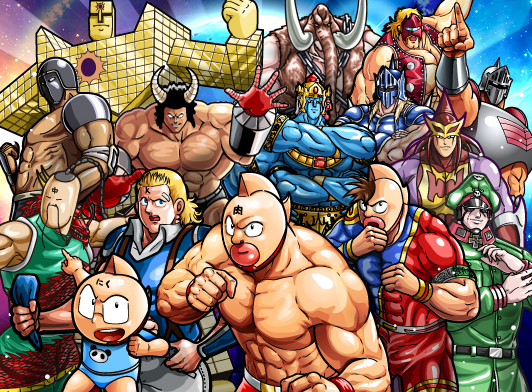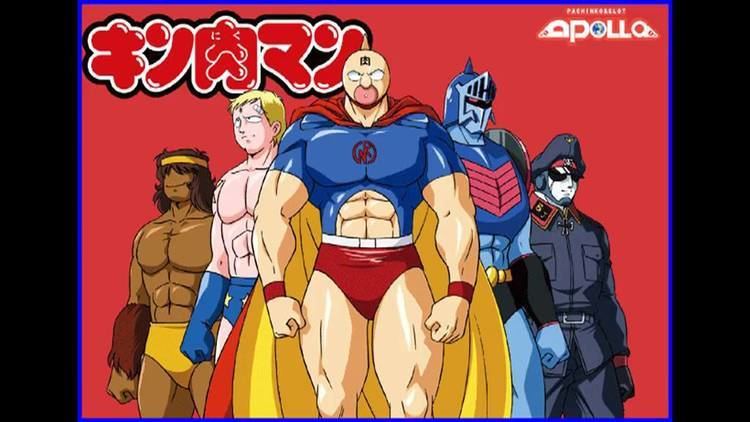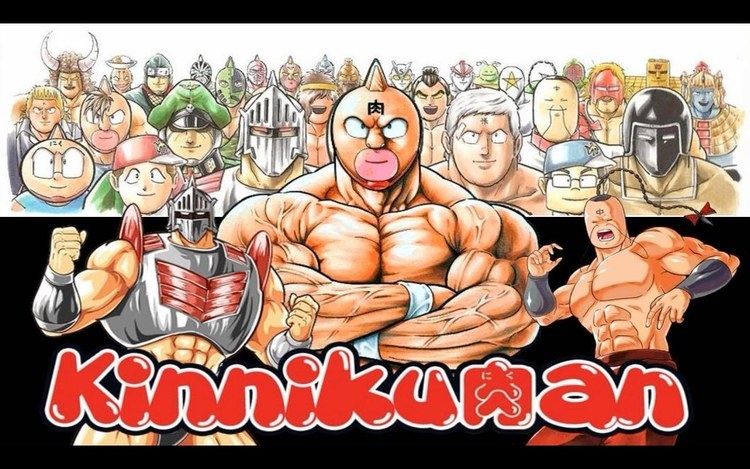 | ||
Magazine Weekly Shōnen Jump (1979–1987)Shū Play News (2011–) Original run Initial runMay 1979 – March 1987Continued run2011 – present Adaptations Ultimate Muscle (2002) Main characters Robin Mask, Warsman, Akuma Shogun, Buffaloman, Terryman Similar One Piece, Dragon Ball, Kingdom, Sakigake!! Otokojuku, Kochira Katsushika‑ku Kameari | ||
Ah kinnikuman anime manga review
Kinnikuman (Japanese: キン肉マン, "Muscle Man") is a manga series created by the duo Yoshinori Nakai and Takashi Shimada, known as Yudetamago. It follows Suguru Kinniku, a superhero who must win a wrestling tournament to retain the title of prince of Planet Kinniku. Nakai and Takashi planned the series when they were attending high school originally as a parody to Ultraman.
Contents
- Ah kinnikuman anime manga review
- Kinnikuman
- Ultimate Muscle The Kinnikuman Legacy
- Publication
- Sequel and spin offs
- Television series
- Films
- Related media
- Video games
- Reception
- Legacy
- References

The manga was originally published in Shueisha's Weekly Shōnen Jump from 1979 to 1987, and was first adapted by Toei Animation into a 137-episode anime series broadcast on Nippon Television from 1983 to 1986. It restarted publication in 2011, and has spawned spin-off manga and anime series, video games, anime films, and several Kinnikuman-related merchandise.

Among the several spin-offs, there is Kinnikuman the 2nd (キン肉マンⅡ世, Kinnikuman Nisei) manga series that was serialized in Weekly Playboy between 1998 and 2004. It was published in North America by Viz Media under the title of Ultimate Muscle. It was also adapted into three different television series, all of which were broadcast by TV Tokyo in Japan and released in North America by 4Kids Entertainment.

The manga series has been popular in Japan, selling over 70 million copies by 2015. As popular as was the anime series and its merchandise, such as Kinkeshi, a line of action figures released as M.U.S.C.L.E. in North America. Although it received the Shogakukan Manga Award for children's manga in 1985, it has received mixed reviews from critics.
Kinnikuman
The story involves Kinnikuman (real name Suguru Kinniku), a clumsy, foolish superhero who discovers that he is the missing prince of the planet Kinniku (known for producing the greatest superheroes in the universe). Since he is a clumsy fool, however, he must prove himself worthy of the throne. To do so he enters wrestling competitions and battles evil Chojin, culminating in a tournament between Kinnikuman and five pretenders to the throne: Kinnikuman Big Body, Soldier, Zebra, Mariposa and Super Phoenix. Many of Kinnikuman's allies begin as villains (Ramenman, Buffalo Man, Ashuraman and Warsman) or arrogant heroes (Terryman, Robin Mask and Rikishiman). The heroes and villains are collectively known as Chojin, which literally means "supermen".
Ultimate Muscle: The Kinnikuman Legacy
Mantaro Muscle (also known as Kid Muscle—Mantaro Kinniku in the Japanese version) is the spoiled son of superhero wrestler King Muscle (Kinnikuman in the Japanese version). After 28 years of peace, the Seigi Choujins' (Muscle League) old enemies regroup and form the Demon Manufacturing Plant (dMp, known in the English version as Destruction, Mayhem and Pain). The Muscle League has lost its edge and are overwhelmed by the young, well-trained fighters. Recognizing their weakness, the Seigi Chojin reopen the Hercules Factory (a school for superheroes) and begin training a new generation of heroes to take on the dMp. At first unwilling, Mantaro (Kid Muscle) is one of the young heroes and defeats his father to prove his readiness to graduate. He and the other new Seigi Choujin defeat several members of the dMp and meet Kevin Mask, who quits dMp when he discovers their lack of honor. They also battle Sunshine and his pupils, who destroy the dMp after developing a renewed respect for the fighting spirit of the Seigi Choujins. The manga continues with the New Generation Replacement Tournament, Mantaro's challenge to master his inherited potential (Kajiba no Kuso Chikara, "burning inner strength" or "the fire"), the return of the Chojin Olympics, a fight with the Demon Seed (a villainous group), a backstory for Robin Mask and a tag-team tournament set in the past. Although the manga begins as a fairly lighthearted, humorous (albeit violent) story, later arcs (the No Respect and Demon Seed storylines in particular) have a darker tone and frequently deal with psychological trauma.
Publication
Yoshinori Nakai and Takashi Shimada, friends since fourth grade, decided to create a manga series in high school. Before its regular publication, the series (originally a parody of Ultraman) was released as two one-shots in Shueisha's magazine Weekly Shōnen Jump in December 1978 and March 1979: Okamarasu no Maki, which won the Akatsuka Award, and Eraginesu no Maki. Its serialization began in the May 1979 issue and concluded in March 1987. Shueisha collected its 387 chapters into 36 tankōbon, releasing them from February 15, 1980 to April 15, 1988.
A one-shot, Muscle Returns, was published in Kadokawa Shoten's Kakutō Ace in January 1996. Despite the title, the series only began regular publication on November 28, 2011 in Shū Play News, Shueisha's web version of Weekly Playboy. The 37th tankōbon was released on January 29, 2010, and the 57th volume was released on December 2, 2016.
The first 36 volumes were re-published as part of the Jump Comics Selection line in 26 volumes from July 19, 1994 to August 26, 1996, as part of the Jump Comics Deluxe line in 18 aizōban volumes from January 14 to November 18, 1999 and on June 6, 2013 all 36 were published in shinsōban format. Kinnikuman was also published in the Shueisha Jump Remix bargain series from 2001 to 2013. From July 5, 2012 to January 3, 2014, 44 e-book volumes were published as part of the Jump Comics Digital line.
Sequel and spin-offs
The first manga spun off from Kinnikuman was Tatakae!! Ramenman, a series focused on Ramenman which was published in Fresh Jump from 1982 to 1988. It was compiled into twelve tankōbon volumes released between 1983 and 1989. In 1998 and 1999, Tatakae!! Ramenman was re-published in 9 volumes, in 2002 in 8 volumes, between 2004 and 2006 in 12 volumes, and in 2009 in 5 volumes. Toei Animation adapted it into a 35-episode anime series, which was broadcast from January 10 to September 11, 1988. In 1988, a film was released on July, and a video game on August. On March 21, 2009, the anime series and film were released in a box set. Also, a spin-off of Tatake!! Ramenman, subtitled Chōjin Dai Meikan, was released in 1995.
After the publication of several one-shots of Ultimate Muscle: The Kinnikuman Legacy from August 1997 to February 1998, it began appearing regularly in Weekly Playboy from April 1998 to 2004 and was published in 29 tankōbon volumes from October 19, 1998 to August 19, 2005. This 29 volumes were released by Viz Media in North America between July 5, 2004, and July 5, 2011. It was re-released in 21 aizoban volumes from September 18, 2009 to January 18, 2011. Three one-shots of Kinnikuman Legacy were published in 2002. The first, Densetsu no Joshō: Heracles Factory, was released on February 22, and the second, SP Densetsu Chōjin Zenmetsu!, was released on May 24. A guidebook titled Kinnikuman Nisei: Chōjin Taizen was released on July 19, 2002.
All Chōjin Dai Shingeki, an Ultimate Muscle: The Kinnikuman Legacy spin-off, was serialized in V Jump from May 2001 to March 2007 and its four tankōbon were published from August 2, 2002 to August 2007. To continue Ultimate Muscle: The Kinnikuman Legacy's storyline, Kyūkyoku no Chōjin Tag Hen was published in serial form from 2004 to 2011 and released in 28 tankōbon from November 18, 2005 to December 19, 2011.
A feminized version of the series, Kinnikuman Lady, was created by Masashi Ogawa and began as a webcomic on the Ultra Jump Egg site in June 2008. Its first tankōbon was published on March 19, 2009, and in 2011 it was moved to the Ultra Jump website. The series concluded with the release of its 46 chapter on Ultra Jump, and the release of third tankōbon, both on June 19, 2013.
Television series
The first animated series based on Kinnikuman was produced by Toei Animation and directed by Yasuo Yamayoshi, Takenori Kawada and Tetsuo Imazawa. The 137-episode series was originally broadcast in Japan on Nippon Television (NTV) from April 3, 1983 to October 1, 1986. It was followed by Kinnikuman Kinniku-sei Ōi Sōdatsu Hen, directed by Takeshi Shirato and Atsutoshi Umezawa. This 46-episode series was produced by Toei and aired on NTV from October 6, 1991 to September 27, 1992. The first series was packaged into 12 DVDs, released from December 6, 2002 to November 21, 2003, and the second series was released on four DVDs from December 5, 2003 to March 21, 2004.
On January 9, 2002, Kinnikuman: Second Generation premiered; the 51-episode series aired until December 25 of that year, and was released on 12 DVDs from September 21, 2002 to August 8, 2003. Licensed by 4Kids Entertainment as Ultimate Muscle: The Kinnikuman Legacy, it was broadcast on Fox Box. In 2003 a 13-episode sequel primarily focused on non-Japanese audiences was announced; it aired on Fox Box in North America, and from April 7 to June 30, 2004 in Japan. Another 13-episode spin-off, Kinnikuman Second Generation: Ultimate Muscle 2, was broadcast from January 4 to March 29, 2006 in Japan. All three series were directed by Toshiaki Komura, produced by Toei Animation and broadcast in Japan by TV Tokyo. The two spin-off series were released as two-DVD box sets on February 24 and June 23, 2006.
Films
Seven films based on the original Kinnikuman were released from 1984 to 1986. The first, Kinnikuman, was directed by Takeshi Shirato and released on July 14, 1984. Kinnikuman: Seigi Chōjin vs. Senshi Chōjin, the last film, was released on December 20, 1986 and was directed by Yasuo Yamayoshi. All seven films were compiled on a DVD released April 21, 2004.
Two films based on Kinnikuman: Second Generation were directed by Toshiaki Komura. The first (eponymous) film was released at the Anime Fair on July 14, 2001 and the second, Kinnikuman Nisei: Muscle Ninjin Sōdatsu! Chōjin Dai Sensō, was released at the same venue on July 20, 2002. The films were released on DVD on May 12, 2002 and April 21, 2003, respectively.
Related media
With the manga's popularity, Bandai produced a brand of eraser-like action figures (keshi) titled Kinkeshi between 1983 and 1987. In Japan, Bandai has released 418 different types of figures, and it was mainly sold through Gashapon. As it attracted Northern American market's interest it was brought by Mattel under the name M.U.S.C.L.E., and a total of 236 figures were traded domestically in the 1980s. In 2007, Toei asked fans if they would like to see all 418 figure types included in the Kinnikuman complete box set. On December 20, 2008, the box set with all the two first series episodes, all seven films, a TV special, and all the figures was released. Aside from this most known series of products, a myriad of other Kinnikuman-based merchandise were released both in Japan and in the America, which vary from action figures to plush dolls, from key holders to pen drives, from picture books to trading card games.
Video games
Several video games based on the series were released. The first were for home computers; a simulation game was released for the PC-88 in November 1984, followed by the 1995 fighting game Kinnikuman: Colosseum Deathmatch. The first console game (Tag Team Match: MUSCLE) was released on November 8, 1985 for Nintendo Entertainment System, and the last game (Kinnikuman: Muscle Grand Prix 2 Tokumori) was released for PlayStation 2 on September 25, 2008. The social networking service GREE released Kinnikuman Memorial on February 27, 2014.
Reception
In 1984, Kinnikuman won the 30th Shogakukan Manga Award in the category Best Children's Manga. The series has sold more than 70 million copies in Japan. The 2013 edition of Takarajimasha's guidebook Kono Manga ga Sugoi!, a survey of the manga and publishing industries, named Kinnikuman the seventh-best manga series for male readers. Several volumes of the series have been featured on Oricon's weekly chart of best-selling manga in Japan; all volumes since the 40th have reached the top 20. As well as Kinnikuman's manga was considered a hit, the series' merchandise in general was also successful. Bandai reports that over 180 million units of Kinkeshi were sold in Japan. Shaenon K. Garrity said, "The M.U.S.C.L.E. figurines ... were the sole American extrusion of a 1980s manga/anime/licensing phenomenon."
The anime series was popular, premiering with a rating over 20 percent. The Kinnikuman complete box set, had 25,000 reservation requests. In 2005, Japanese television network TV Asahi conducted a "Top 100" online web poll and nationwide survey; Kinnikuman placed 97th in the online poll and Ultimate Muscle placed 39th in the survey. In 2006, TV Asahi conducted another online poll for the top one hundred anime, and Kinnikuman placed 12th in the "Celebrity List".
Garrity called Kinnikuman a "cross between superhero parody and pro-wrestling goofiness". Liann Cooper of the Anime News Network said that the "artwork alone is enough to clothesline itself and the whole concept of superhero wrestlers is like a manga-fied Mucha Lucha", but Ultimate Muscle "is actually pretty funny". Eduardo M. Chavez of Mania.com wrote that in 1979, "the series relied on its comedy and action to bring in an audience." Ultimate Muscle, while "keeping some of the old silliness", adds "some depth through a mature writing style and better action scenes." On T.H.E.M Anime Reviews, Christi wrote, "Overall, Ultimate Muscle is the best thing about the Fox Box anthology." She praised the "funny, and in their own disgusting way, charming" characters, its "crisp and well-done" animation and the "very clean and appealing" character designs.
Legacy
Widely regarded as a classic manga series, it has been cited by Fullmetal Alchemist creator Hiromu Arakawa as a series she "love[s]" and as an influence to her work, as well as by Fairy Tail's Hiro Mashima. Moreover, Kinnikuman has inspired real life wrestling events. At the Fight Entertainment Group's FieLDS Dynamite!! 2008 event in Saitama, Japan, Bob Sapp fought Kid Muscle (played by Akihiko Tanaka) in an MMA match. Toei Animation announced a Kinnikumania 2009 wrestling event, scheduled at the JCB Hall in Tokyo Dome City on May 29, 2009 for the manga's 30th anniversary. Its enduring popularity is also shown by Kinnikuman being used to co-promote Green Lantern in 2011 for the Japanese release of the film.
